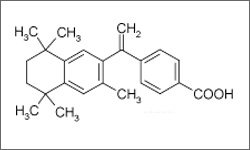Bexarotene

Bexarotene is primarily used in the treatment of a certain type of lymphoma called cutaneous T-cell lymphoma that appears on the skin. Bexarotene is administered orally as a capsule and also as a topical gel.1
- 1 Targretin.. Prescribing Information. Ligand Pharmaceuticals Incorporated. [http://www.ligand.com]
Bexarotene (Targretin®) activates retinoid (vitamin A) receptors which are responsible for controlling cell division. The exact mechanism by which bexarotene kills cancer cells is still unknown.1
The diagram above shows the 3D molecular structure of Bexarotene.
- 1 Chu, E., & DeVita, V. T. (2015). Physicians' cancer chemotherapy drug manual 2015. Burlington, MA: Jones & Bartlett Learning.
Common side effects include blood lipid level changes, tiredness, weakness, headache, decreased thyroid hormone levels, skin abnormalities. The side effects listed above are those for the oral form of bexarotene. Side effects for the topical form of bexarotene are usually localized to the application area and most commonly include rashes, other skin abnormalities, and also pain. Most patients experience changes in the levels of fats (such as cholesterol and triglyercides) in the blood. For this reason these levels are monitored closely by blood test and if elevated may require additional medication for control. Bexarotene may have effects on other systems of the body which need to be monitored during treatment. These effects may include a decrease in white blood cell count or cataract formation. Also, bexarotene causes pancreatitis in a very few number of patients and may cause a change in insulin demand in diabetic patients.1
- 1 Chu, E., & DeVita, V. T. (2015). Physicians' cancer chemotherapy drug manual 2015. Burlington, MA: Jones & Bartlett Learning.
Bexarotene should not be taken by women who are pregnant and patients should not become pregnant while using this drug, as it may have harmful affects on the developing fetus.
